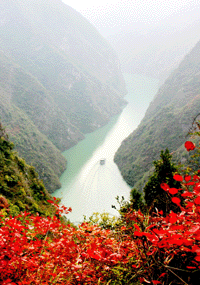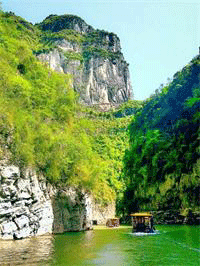The Wu Gorge is named after Wushan Mountain . The beautiful gorge runs 45 kilometers from the mouth of the Daning River in Wushan County , Chongqing , to Guandukou in Badong County . Huibei province, with the Bianchengxi serving as the dividing line between Chongqing and Hubei .
Along the Wu Gorges, tweleve peaks are the best attractions to tourists. On the nortghern bank of this part of the Yangtze from west to east stand six peaks: Denglong, Shengquan, Chaoyun,Shennu, Songluan, and Jixian; on the southern bank only three peaks are visible to the passenger on a ship; Feifeng, Cuiping and Juhe, while the three other peaks, Jiangtan, Qiyun and Shangsheng are hidden behind the mountains as they stand a little way off from the Yangtze, Denglong, 1,210 meters above sea level is the highest peak among them, while the 940-meters Qiyun is the lowest. The 940 meters Shennv or the Goddess Pea k is also known as Greeting the Rosy Clouds Peak , because its column like top seems always to be greeting the rosy clouds both at sunrise and at sunset. It is named the Goddess had fallen in love with King Xiang of the state Chu, and they enjoyed their meeting in Wushan Mountain, and in his dream the king was told by the goddess that she would appear as the cloud at dawn and as rain at sunset. As the Wu Gorge is long and valley deep, and the area is crowded with piles and piles of mountains and peaks, and so the area is very often shrouded in mist or a curtain of rain. Therefore, the clouds and rain of Wushan became the theme of many poems and paintings in Chinese history. |
|

 |
| "The Wu Gorges is layers upon layers of mountains and peaks, which are famous for their magnificent scenery, the twelve peaks of Wushan Mountains ." The fifteen large Chinese characters, said to be written by Zhuge Liang(Kongming), prime minister of the State of Shu (221-265), are inscribed on a rock cliff of the Jixian Peak over the river, and therefore is known as "the Kongming Tablet". But in fact the first six characters were carved during the reign of Emperor Jiajing (1522-1567)of the Ming Dynasty, and the last nine characters have almost been worn away which makes studies almost impossible. |